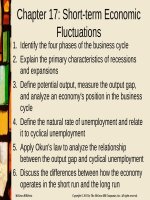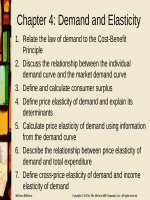Lecture Principles of economics (Asia Global Edition) - Chapter 7
Bạn đang xem bản rút gọn của tài liệu. Xem và tải ngay bản đầy đủ của tài liệu tại đây (726.43 KB, 10 trang )
<span class='text_page_counter'>(1)</span><div class='page_container' data-page=1>
Efficiency, Exchange, and the
Invisible Hand in Action
</div>
<span class='text_page_counter'>(2)</span><div class='page_container' data-page=2>
Learning Objectives
1. Define and explain the differences between
accounting profit, economic profit, and normal profit
2. Explain the Invisible Hand Theory and show how
economic profit and economic loss affect the
allocation of resources across industries
3. Explain why economic profit, unlike economic rent,
tends toward zero in the long run
4. Identify whether the market equilibrium is socially
</div>
<span class='text_page_counter'>(3)</span><div class='page_container' data-page=3>
Markets Are Dynamic
•
Every time you see one of these signs, you see
the market dynamics at work:
– Store for Lease
– Going Out of Business Sale
• Everything Must Go
– Now Open
– Close-Out Model
</div>
<span class='text_page_counter'>(4)</span><div class='page_container' data-page=4>
The Invisible Hand
•
Individuals act in their own interests
– Aggregate outcome is collective well-being
•
Profit motive
– Produces highly valued goods and services
– Allocates resources to their highest value use
• LeBron James does not receive training as a
</div>
<span class='text_page_counter'>(5)</span><div class='page_container' data-page=5>
Accounting Profit
•
Most common profit idea
<b>Accounting profit</b> = total revenue – explicit costs
– <b>Explicit costs</b> are payments firms make to
purchase
• Resources (labor, land, etc.) and
• Products from other firms
•
Easy to compute
</div>
<span class='text_page_counter'>(6)</span><div class='page_container' data-page=6>
Economic Profit
•
<b>Economic profit</b>
is the difference between a
firm's total revenue and the sum of its explicit
and implicit costs
– Also called excess profits
•
<b>Implicit costs</b>
are the opportunity costs of the
resources supplied by the firm's owners
•
<b>Normal profit</b>
is the difference between
</div>
<span class='text_page_counter'>(7)</span><div class='page_container' data-page=7>
Three Kinds of Profit
<b>Total</b>
<b>Revenue</b> <sub>Explicit</sub>
Costs
Accounting
Profit
Normal
Profit
Economic
Profit
Explicit
Costs
Total Revenue = Explicit Costs + Accounting Profit
Economic
</div>
<span class='text_page_counter'>(8)</span><div class='page_container' data-page=8>
Example: Economic Profit
Guides Decisions
•
Kim Hyun-woo's decision: continue farming or
quit?
– Quit farming and earn $11,000 per year working
retail
– Explicit farm costs are $10,000
– Total revenue is $22,000
<b>Accounting </b>
</div>
<span class='text_page_counter'>(9)</span><div class='page_container' data-page=9>
Example: Economic Profit Guides
Decisions, A Change in Revenue
•
Kim Hyun-woo's decision: continue farming or
quit?
– Quit farming and earn $11,000 per year working
retail
– Explicit farm costs are $10,000
– Total revenue is $20,000
– Kim should quit
<b>Accounting </b>
<b>Profit</b>
<b>Economic </b>
<b>Profit</b>
<b>Normal </b>
<b>Profit</b>
</div>
<span class='text_page_counter'>(10)</span><div class='page_container' data-page=10>
•
Rent for the farm land is $6,000 of the $10,000
in explicit costs
– What changes if Kim inherits the land?
• His rent payments become an implicit cost
<b>Total </b>
<b>Revenue</b>
<b>Explicit Costs Implicit Costs</b>
$20,000
$4,000
$17,000
<b>Accounting </b>
</div>
<!--links-->









